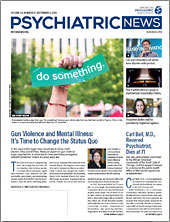Acute agitation is a state of intense anxiety, heightened arousal, and increased motor activity that may occur in the context of a variety of psychiatric and general medical disorders. Agitated patients are typically uncooperative, hostile, and sometimes aggressive, posing risks both to themselves and to their caregivers. Rapid assessment and effective treatment are essential to safely address this emergent condition.
Agitation should be viewed as a symptom, not an independent disorder, and the context in which it occurs will help inform its management. Psychiatrists will most often encounter acute agitation due to of one of these underlying conditions:
•
Alcohol or sedative withdrawal
•
Dementia or other cognitive impairments
•
Drug or alcohol intoxication
Safety First
In practice, it is most effective to treat agitation as soon as it develops. Medical professionals, particularly nursing staff, should be alert to initial signs that a patient is becoming more agitated—such as increased tension or motor activity, discomfort or lack of cooperation with staff, and rude and dismissive comments—and should begin interventions promptly. It is far easier and more effective to treat a patient who is just beginning to look tense and distressed with a reassuring word and an offer of medication than to try those steps when the patient is physically and/or verbally aggressive.
Regardless of a patient’s state, the highest priority of treatment is to ensure the safety of the patient, staff, and others who might be present. However, this must be balanced with the ethical and legal priorities of treating the patient with the least-invasive interventions in the least-restrictive setting possible. The spectrum of possible interventions ranges from verbal de-escalation to voluntary medication, involuntary medication, room seclusion, and, finally, physical restraint.
If medication management is needed, the goal is “rapid tranquilization.” This entails administration of the therapeutically appropriate medication in the optimal format and at the optimal dose to prevent the patient from self-harm or harming others, alleviate the patient’s distress, and assist the patient in recovering and maintaining self-control. Optimal dosing includes recognition that medication effects may not be immediate and that higher-than-recommended doses do not shorten response times. The timing and effect of each medication dose must be systematically recorded, and the total amounts of all medications carefully tracked.
Medication Options
The primary medications used for acute management of agitation are antipsychotics and benzodiazepines, each available by multiple routes of administration (see
table).
In comparing the two classes, antipsychotics have the advantage of addressing underlying psychotic, manic, or delirium symptoms; they also provide a general calming effect, though their degree of sedation varies. Benzodiazepines provide more consistent sedation and can also reduce anxiety and withdrawal symptoms. Benzodiazepines may be satisfactory as monotherapy in cases of mild agitation, but antipsychotics are preferred in more severe cases. The combination of an antipsychotic and a benzodiazepine is usually more effective than either agent alone. As a caution, injectable olanzapine should not be combined with injectable benzodiazepines due to the risk of excessive sedation and respiratory problems.
Oral medications are easy to administer and more acceptable to patients. Additionally, there are more medication options to choose from. However, none of the medications is approved by the Food and Drug Administration (FDA) for acute agitation, and data on their relative effectiveness are limited. Also, patients can fake the ingestion of tablets (known as “cheeking”), so oral administration is best suited for fully cooperative patients.
Some antipsychotics are available as sublingual tablets; these formulations are more difficult to “cheek” and can be used with a lower level of cooperation. Sublingual and orally disintegrating tablets are absorbed at the same rate as standard tablets and do not provide more rapid relief of symptoms.
The length of time it takes medications to take effect can vary greatly, but peak blood concentrations typically are achieved one to six hours after oral ingestion. Higher doses will not decrease this time, so do not go above recommended dosages.
For oral administration, use of a medication that a patient is currently taking or has previously taken has the advantage of being familiar and tolerable to the patient. For patients with no history of antipsychotic use, any antipsychotic may be appropriate, but the ease of administering orally disintegrating or sublingual tablets makes them an attractive option if available. Haloperidol is also commonly used for oral administration as it is inexpensive and widely available in most psychiatric and other medical settings.
Injectable medications have the advantages of more rapid onset of action, assured compliance, and FDA indications for use in acute situations. Disadvantages include poor patient acceptance, the possible need for physical restraint for administration, and risk of the patient and/or staff being inadvertently stuck with the needle during a potentially volatile situation. Although both first- and second-generation antipsychotics are available as intramuscular injections, only first-generation antipsychotics such as haloperidol may be given intravenously, as might be preferred on a medical unit.
Among the benzodiazepines, lorazepam has several compelling advantages. It is the only drug of this class that is available for oral, intramuscular, and intravenous administration. It has no active metabolites and is safely metabolized even in the presence of severe liver dysfunction. It has been widely used, and its utility in acute agitation is well established. ■

